#1780s mourning
Text
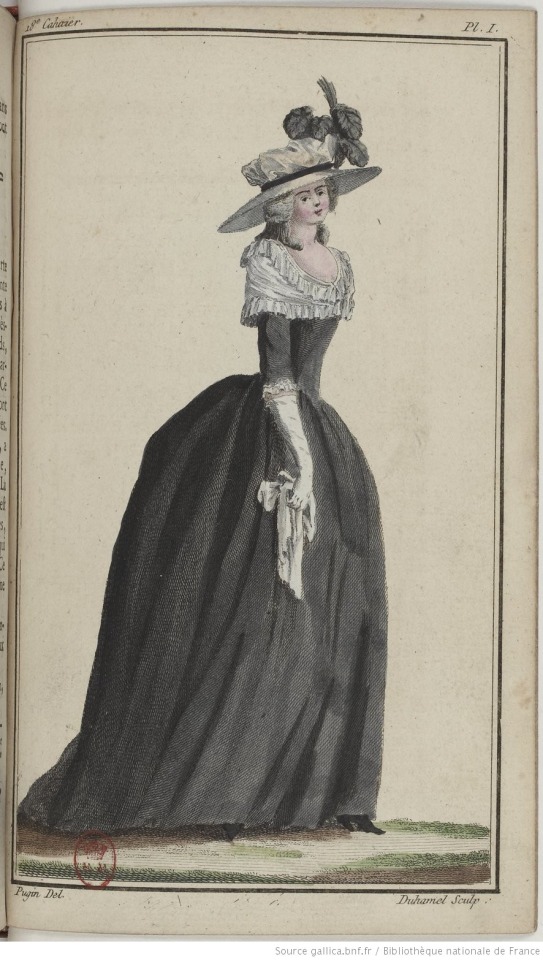
Fashion Plate, 1786, French.
From Cabinet des modes.
Portraying a woman in a black taffeta mourning dress.
BNF Gallica.
#womenswear#france#french#fashion plate#1780s#1780s fashion plate#dress#1780s dress#1786#cabinet des modes#bnf gallica#mourning dress#1780s mourning#mourning#reign: louis xvi
66 notes
·
View notes
Text
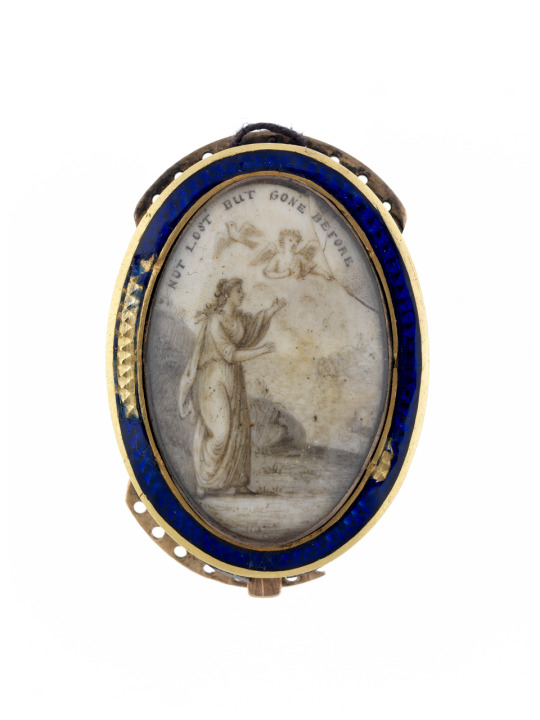
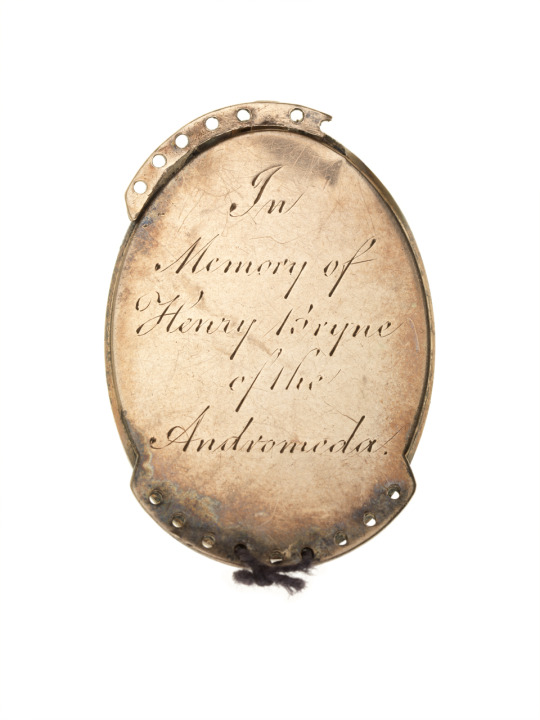
Mourning brooch, c. 1780
An oval mourning brooch with, on the left, against a background of rocks, a symbolic classical female figure facing right with arms raised. Over its head are a flying dove and the head and torso of a winged putto, pointing down to the right. Above are the words 'NOT LOST BUT GONE BEFORE'. The backplate is inscribed 'In Memory of Henry Bryne of the Andromeda'
Henry Bryne was captain of the 28-gun frigate 'Andromeda' (a sixth-rate, built 1777) and drowned in October 1780 when she was lost in a West Indies hurricane.
153 notes
·
View notes
Text
Augustin-Alphonse Gaudar de Laverdine, 1780/1804, Neoclassical painter.

Grand Prix de Rome in 1799, died at age 24 of an unknown cause during his stay at the Villa Medici in Rome.
Residents of the Villa Medici are required to send a work to Paris annually, evaluating the artist by the work produced.
The works of Gaudar de Laverdine are therefore essentially what we call “sends from Rome”
Gaudar laisse à sa famille un portefeuille important de dessins révélant un lauréat destiné à une carrière qui s’annonçait prometteuse, tout particulièrement son travail sur le nu, la figure, les scènes historiques.
1800, Cyparis mourning the death of his deer.
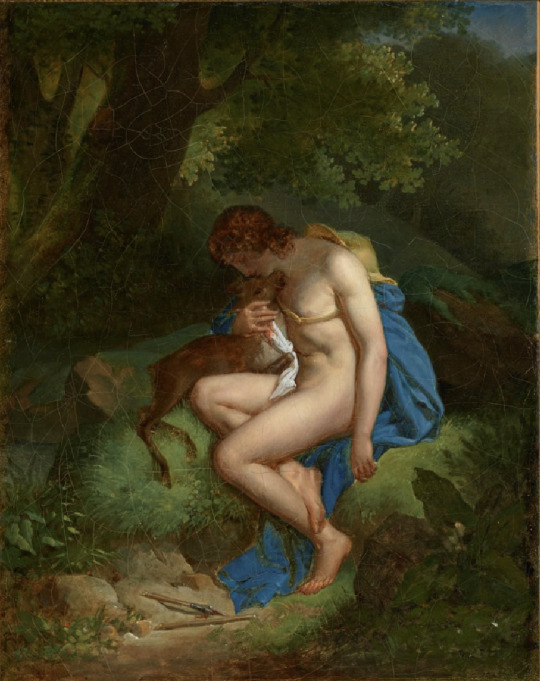
1800/01, Narcissus admiring himself in the water.
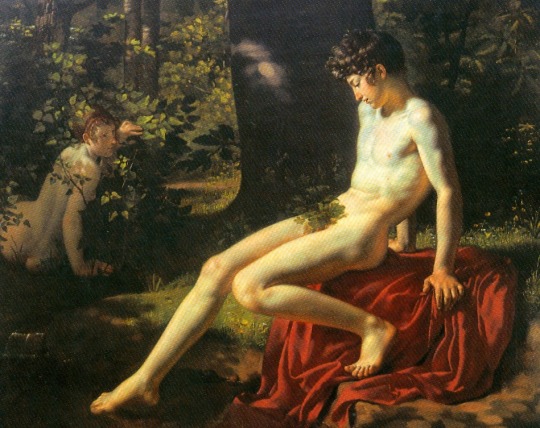
In this version Narcissus, sitting naked on a rock, does not look in the water for the features of his rather feminine face framed by blond curls. But he delicately dips one foot to disturb his reflection, absorbed in his games, indifferent to Echo who observes him, naked hiding in the foliage.
1801, Half-figure torso in a classic position of the Royal Academy of Painting, however with a half-visible penis

1802, Ariadne abandoned by Theseus

After killing the Minotaur, following a storm, Theseus is forced to hastily raise the sails, leaving Ariadne sleeping on the island of Dia. But returning to look for her, not finding her, he returns in despair to Athens where he marries Phèdre, Ariadne's sister.
The tree she cries on symbolically represents the one who will save her
Dionysus, to whom she is promised.
1803/04 Roland furious.

Scene taken from Ariosto's Canto XXIII, the naked man, braced, breaks the trunk of a large pine tree, the pieces of his armor at his feet.
37 notes
·
View notes
Text

I know we probably shouldn't pay much attention to this and it could be very much a typo but these dates are driving me mad. What do you mean 1780? That makes him 20 years younger than Lestat it makes no sense unless it marks the moment when the Talamasca starts keeping tabs on him and it has something to do with the Witches Place when he's 10 maybe (that storyline is sacred to me and I wouldn't want them to get too creative about it but I would welcome anything that focuses on Nicki even if it is made up). It's the 1882 date that rips me apart. Nicolas is not supposed to live past 30 and Lestat mourns him for 100 years that was the deal😭😭😭

This one though. It's gotta be a typo 🤣🤣🤣
13 notes
·
View notes
Text

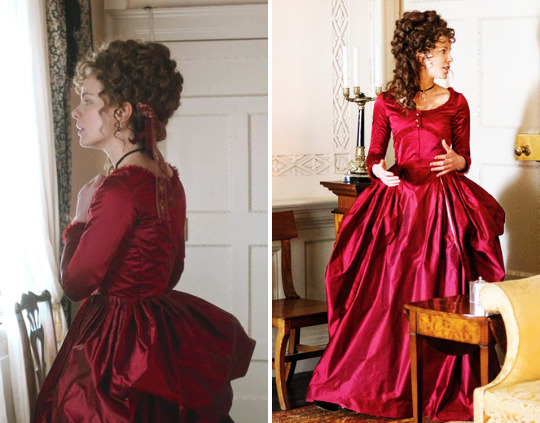




One Dress a Day Challenge
January: Red Redux
Love and Friendship / Kate Beckinsale as Lady Susan Vernon
In the country, Lady Susan continues to wear demure mourning gowns, but on a trip to London, she lets loose with this spectacular ruby-red satin.
Costume Designer Eimer Ni Mhaoldomhnaigh had this to say about the costumes for this film, which were apparently done on quite a tight budget:
"So this is a little novella that she [Jane Austen] wrote, one of the first things that she wrote, so it’s set earlier than most of her big novels like Pride and Prejudice and all of those. So we decided to set the film a little bit earlier also, like late 1780s or 1790s, so the fashion between 1790 or even the mid 1790s really changed quite dramatically. A lot of it was influenced by the French revolution, historical events that were happening at the time.... I really kind of pushed for setting it in the late 1780s. It’s a comedy as well, these big dresses, these really lend themselves to--there’s such a drama about those costumes. I just felt that it would really add to the performance, the door would open and she went swoosh into the room (laugh) and this huge dress, o my gosh, these dresses are built for something like this, for drama and comedy and fun."
#love and friendship#red dresses#kate beckinsale#one dress a day challenge#one dress a week challenge#love & friendship#lady susan#lady susan vernon#18th century costumes#18th century fashion#18th century style#austen adaptations#movie costumes#2016 films#2016 movies#1790s fashion#1790s#Eimer Ni Mhaoldomhnaigh
109 notes
·
View notes
Note
🖊🖊
Been thinking a lot about TURN: Washington’s Spies and the American Revolution lately. So here’s every original character I can theoretically stick into that universe… @eurydicefades 🫡
American Revolution podcast.
American Revolution: playlist.
TURN: playlist.
Benjamin Tallmadge: playlist.
Rococo playlist.
French History podcast.
In no particular order…

Audrey: based on Kitty Fisher and Charlotte Hayes, born 1750, turned 1780 at the age of 30. Well-to-do sex worker, coquette, disowned daughter of a Viscount. Abolitionist. She/they, bisexual-polyam. Vampire.
Camille: based on Mary Wollstonecraft and various French Revolution ladies. Audrey’s half sister, unlike her, never disowned, still hates her Viscount father. Abolitionist, anti-monarchist, pamphlet writer, and social climber. Turned into a vampire in 1790. She/her, bi. Vampire.
Artémise: Dutch and Black-Creole New York socialite, spy for the culper ring, and violinist. An informant, a fashionista, bit of diva, excellent listener. Will sell you out to Benjamin Tallmadge. She/her, bi.
Benjamin Fisher: Benjamin Tallmadge, vampire/anti-hero arc. He/him, bi (closeted). Staff to Washington, from New York, trying really hard to be good, but vampirism won’t let him. Turned by Audrey in 1781. Vampire.
Charles: Colonel in the British army. Good at following orders, only doesn’t like his job. It’s a constant existential crisis, he knows neither side is right, he’s sworn to the British by duty not by choice. Scottish and French, English born. Based vaguely on Ross Poldark. He/him, bi. Has a deceased wife and daughter he’s still mourning.
Eliott: Spy for the British army. Follows orders for social gain and security, not cause he wants to. Poet turned spy, he/him, bi. Much like Tallmadge, he is a young man, having control taken from him far too often. Really just doesn’t want to be hung as a traitor to the crown. Irish and Catholic. Hates all of the army, expect Major André and Simcoe.
Carlotta aka Charlotte: French socialite, unknowing informant to the Patriots. She/her, bi. Somewhere between culper ring spy and French nobility looking to escape France due to pending revolution back home. 1/2 characters here who are not made for battle situations.
Edith: Maryland based loyalist, loyalist out of love for her family. She/her, bi (closeted). Catholic but very English. A civilian caught in a bad situation, didn’t do anything wrong, unless love for one’s family is a sin. Honestly reminds me of a Liberty’s Kids character and Sarah Livingston (Turn) but younger. Of marriageable age (24), good natured, well meaning, loyalty to what she deems moral just has her in a bad situation.
Harriet: Boston based dress maker and painter, sometimes pamphlet writer. Free woman of global majority (colour), Black and Welsh. She/her, bi. Yet another civilian caught in a war they didn’t ask for. Declares neutrality to survive, probably more on the side of the continental army, but she’d rather not the gallows.
Verity, Nancy & Sally/the tombeor polycule: their last name isn’t actually their last name, it’s a French title meaning “performer.” Like a code name. A polycule of three black/Irish sex worker women who are all dating each other and their clients, at the same time, she/her(s) all bi-poly-sapphic. Sex workers and spies for the culper ring, but their loyalty isn’t a cheap. Technically they declare themselves neutral in the war, it’s all lies.
#meera answers#ashfordlabs#answered#oc: Audrey#oc: camille#oc: artémise#oc: Benjamin fisher#oc: charles#oc: Eliott Baird#oc: Carlotta#oc: edith#oc: Harriet#oc: verity#oc: sally#oc: Nancy#18th century#american revolution#turn: washington's spies#bisexual#turn washington's spies#amc turn#turn amc#queer#lgbtq+#vampires#monstrous other#writing historical fiction#historical fiction#writing horror#gothic horror
15 notes
·
View notes
Text
The spirit of Les Innocents
(Open starter for Ghost!Human!Nicolas)
The cemetery of Les Innocents was gone- it had been closed since 1780, it's bodies taken to other tombs, and now the place Joachim-du-Bellay stood on its grounds. But nevertheless, it was haunted. What was the march of urban progress to the restless dead?
Usually, the haunting was experienced as a sound. A mournful wail. A high-pitched screech. A panicked scream. Sometimes it even sounded like music. People debated whether the haunting cry was a human voice at all, or the plaintive strings of a violin.
Like any haunting, it was dismissed by most, and debated fiercly by true believers. There was no consensus of which of the cemetery's dead still lingered, or whether it was just one spirit at all. Few people ever heard anything at all. Fewer still ever saw even the hint of the spectre- a young man in torn and filthy clothes, marred by wounds and bruises.
2 notes
·
View notes
Note
Forgive me and my many asks about baby mattson and Roman I just have feelings oaky but back in like the mid 1780s this thing popped up called a ‘lovers eye’ pendants. It was a pendant painted with just the eye of a persons love so like no one but the wearer would know, who it is or what it’s for.
Baby mattson makes one of Roman’s eye for herself when ya know, they are all hiding there romance still and wears it on a choker and Roman has one of baby mattsons eye, that baby also made just
“If we can’t say we’re together yet, this can be our secret. It was big in the 1780s, a sneaky rebellious way to say you had a lover without saying who.”
Roman keeps his as a keychain almost, he looks at it a lot.
Babys is on a like choker necklace like one of those cool velvet ones that is very vampire aesthetic chic.
I like to think baby mattson is very into Victorian and Edwardian fashion and history and does lots of the tricks and art of those eras.
Meaning she def makes mourning jewelry with hair or teeth, and has memento Mori rings and Victorian hair art pieces she sells all over the world for people. She sells recreation and safe for the skin beauty products that would have been made in the Victorian and Edwardian times.
She has the vintage dress down and has many vintage/Victorian home pieces in her apartment in both new York and Sweden. And Roman is both terrified and let’s her tell him all about the gadgets and hair tools and beauty powders.
I LOVE BABY MATTSON AND ROMAN A LOT OKAY okay.
No my love, I love all your asks!!! I don't mind at all!!! Yesss I've seen them on tiktok and I absolutely love them!!!! Those big brown eyes make Baby Matsson melt!!! He can't help but smile to himself whenever he looks at the keychain, reminded that he loves them and they love him 💞 HE LOVES TO LISTEN TO THEM!!!! You know Lukas just waves them off like idc about creepy jewelry and dead looking makeup but Roman has all sorts of questions and once, just once, lets them do his makeup lol. I LOVE THEM!!! Xoxoxo💜💜💜
7 notes
·
View notes
Text

Fashion Plate, 1786, French.
From Cabinet des modes.
Portraying a man in mourning dress.
BNF Gallica.
#fashion plate#1780s#1780s france#1780s fashion plate#french#France#cabinet des modes#bnf gallica#mourning#mourning dress#1780s mourning
9 notes
·
View notes
Text
The death of Captain Cook- 14th Febuary 1779
When Captain James Cook came to the Hawaiian Islands in 1779 during his third voyage around the world, he had no idea what nasty consequences this would have for him.
At first, everything went as planned. The Hawaiians got on well with the Europeans and presumably (this circumstance has long been disputed and should therefore be regarded with caution) even thought Cook was the return of a seasonally revered deity, Lono, because his arrival coincided with the corresponding time at which this supernatural being was supposed to arrive.
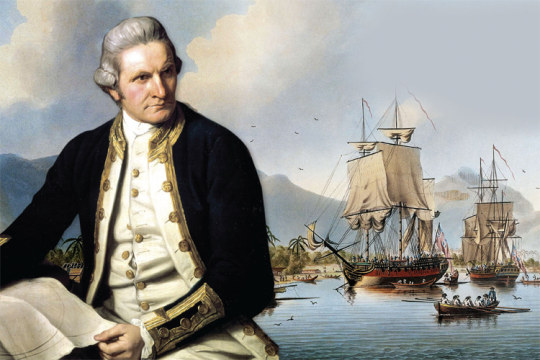
(x)
As Cook left two days later, on 4 February 1779, all was initially quiet. However, when he returned on 11 February to replace a Resolution mast that had been damaged in the storm, relations were testy, for the Hawaiians were puzzled by the totally unexpected return of their god, whose season had now expired. They became suspicious and quarrels between the natives and the whites became more frequent. To put it politely, they behaved like elephants in a china shop. They disregarded the customs and habits of their hosts and even buried a Sailor in a place only allowed for chiefs.
When islanders stole the Resolution's large boat to punish their invaders by taking something valuable from them. Cook captured the local king Kalaniʻōpuʻu as a hostage for its return - something he had, by the way, successfully done many times before on his voyages to get what he wanted. However, considerable unrest ensued because the king refused to comply with his transfer to the ship.
When Cook and a few companions came ashore in a small boat, the confrontation escalated. This included the firing of rifle shots and his men trying to get back into the boat and thus to safety. Whether Cook was then killed from behind or stabbed to death because he turned towards the boat and shouted to his men not to shoot is not clear. In any case, he is said to have fallen forward into the shallow water, while the rest of the small crew remaining in the dinghy tried to escape from the danger zone together with their boat without giving their captain any help.
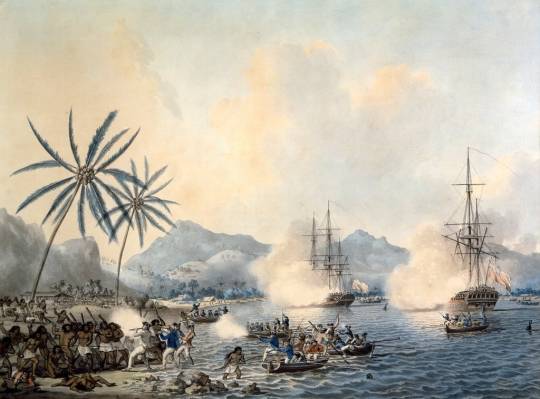
The Death of Cook, John Cleveley the Younger, 1784 (x)
Thus James Cook, as well as four marines and some Hawaiians, died on 14 February 1779.

Account of Cook’s death written by midshipman Trevenen who was present in Resolution‘s cutter literally only metres away from Cook when he was killed in Carricacoolah Bay, Hawaii, on 14th February 1779. Likely written on board Resolution (x)
After the incident, Captain Charles Clerke took command of the expedition and the Resolution, handing the Discovery over to Lieutenant John Gore. Clerke was wise enough to refrain from reprisals and, through the mediation of the priest and a son of the king, was at least handed over some of Cook's body parts and those of the maritime soldiers, which lasted until 20 February, as his body was dismembered and distributed to several higher-ranking natives, which was not uncommon among the inhabitants of Polynesian space at the time. As a rule, the fragments of respected enemies and chiefs were even given a certain veneration. Cook was identified by a burn on his right hand that had occurred years earlier in New Zealand. A burial at sea was held for him in the bay on 21 February.

Captain James Cook mourning ring, owned by Elizabeth Cook, ca. 1780 (x)
The next day, the ships departed for home. News of Cook's death reached England by land six months before the ships returned home. His successor tried to continue the mission, but failed at 70° 33' N due to the pack ice, which seemed even stronger than the previous year. On the return voyage to Petropavlovsk, Captain Clerke died at the age of 38. Virginia-born Lieutenant Gore, who had already taken part in Cook's first Pacific voyage, led the expedition back to England, where it arrived on 6 October 1780.
66 notes
·
View notes
Text
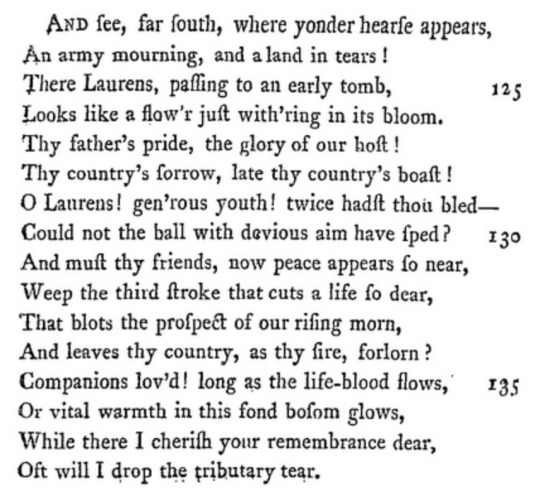
And see, far south, where yonder hearse appears,
An army mourning, and a land in tears!
There Laurens, passing to an early tomb,
Looks like a flow’r just with’ring in its bloom.
Thy father’s pride, the glory of our host!
Thy country’s sorrow, late thy country’s boast!
O Laurens! gen’rous youth! twice hadst thou bled—
Could not the ball with devious aim have sped?
And must thy friends, now peace appears so near,
Weep the third stroke that cuts a life so dear,
That blots the prospect of our rising morn,
And leaves thy country, as thy sire, forlorn?
Companions lov’d! long as the life-blood flows,
Or vital warmth in this fond bosom glows,
While there I cherish your remembrance dear,
Oft will I drop the tributary tear.
Extracted from ‘Address to the Armies of the United States of America’, in The Miscellaneous Works of Colonel Humphreys (1790)
Colonel David Humphreys was an aide de camp to General Washington, joining in 1780 as a replacement for Laurens, who was a prisoner of war at the time, and then appointed special envoy to Versailles. Humphreys met Laurens before he departed for France, and must have heard many flattering things about him from the rest of the military family besides.
Source
42 notes
·
View notes
Text
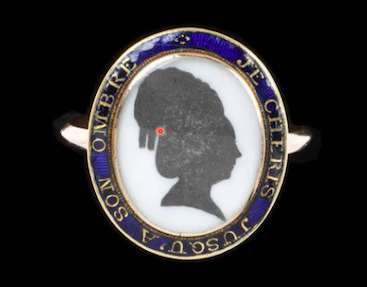
“Mourning" ring with inscription (circa 1780) presented in “A History of Jewellery: Bedazzled (part 4: Rococo Elegance)” by Beatriz Chadour-Sampson - International Jewellery Historian and Author - for the V&A Academy online, February 2024.
0 notes
Note
"You are telling me that man dressed in red is not a deity of some kind? I refuse to believe it." He scoffed, sinking a little deeper onto the couch as he watched a Christmas special on television. "He has been alive for countless years and has the power to quietly enter thousands of homes in a single night. That is truly incredible power." (tyler)

Tyler couldn't help but laugh in his hands, the idea that Santa Claus would be seen as a Deity but the more he listened to his friend of another time, place, world almost even though it was Earth just years and years before his own birth - he waited until Rider was completely at peace with his rambling. "Okay, listen to this… " Tyler moved to pause the credits that began to roll, the music was jolly but now muted, Tyler moved to face Rider on the sofa. "Santa Claus, the movie version you're seeing now? Actually a manifestation of beliefs and actually others taking another language translation for their own." He chuckled, moving to talk with his hands a bit.
"Sint Nikolaas, Dutch nickname, was the name of a St. Nicolas way back in the day. It is believed that Nicholas was born sometime around A.D. 280 in Patara, near Myra in modern-day Turkey. He was a good dude and all that, but the legend really started with that he gave away all of his inherited wealth and travelled the countryside helping the poor and sick. One of the most-known St. Nicholas stories is the time he saved three poor sisters from being sold into slavery or prostitution by their father by providing them with a dowry so that they could be married." Tyler knew it was a bit grim, but they all started somewhere dark. It was how many ghost stories, legends, fae and gods were created by faith of the unknown. "Basically, Nicholas’s popularity spread and he became known as the protector of children and sailors. The real person, St. Nicolas was celebrated in Holland still, hence Sint Nikolaas aka Sinter Klaas the shorter version."
Tyler looked over Rider for a moment, smiling in hopes they were following. "Basically, jump a bit into the 1770's? 1780s? One of these, A newspaper or something spoke about St Nic being mourned and celebrated by Dutch families, those from Holland and whatnot. The festive decorations, stockings, toys, fruit bowls, all that you saw in the movie with the tree and tinsel. Long story short, the guy did exist in a form, but not the form you see now. The red and what not was bought in later down the line and Santa Claus to use with English tongues, believed him to be this great man that appeared one night on Christmas to give gifts and look after the sick and kids. Of course, greed of us humans got involved, a mascot for a Festive season - hence the madness of gifts, presents and whatnot as soon as the Red Man comes out on TV or on signs around the streets."
Looking over Rider a bit more, Tyler tilted his head hoping the other was following. "Basically, he could be a Deity at this point, real as the faes in my attic but the innocent belief in him with children is a little easy to break once you realize that the presents bought for you are from your own parents, family members - etc. You ask for it when asked what you'd like. Sometimes it's preplanned, sometimes it's asked for on Santa's lap, which was a gimmick for Toy Store's back in the day - the kid asked for a barbie doll, boom - got the new latest barbie doll that was on TV a week prior." He shrugged a shoulder though.

"Though, again - he could be a Deity that only true believers see like some Fae and Demons, but yeah - he is definitely man-made in my opinion. Made from a real names care and want to be kind in the world. Twisted almost into his fat dude from the North Pole, has elves making toys in his workshop and flying reindeer."
#ardenssolis#« ( Tyler ) » Answers.#» | × | Tyler&Rider || Meeting You Feels Like Walking Into A Dream ||#tyler underneath this; learning that santa wasn't real killed me rider - i was hoping he was a fae or something cool but NO IT WAS MY MOM#BUT NOW I'M TOO OLD TO BELIEVE IN HIM
1 note
·
View note
Text
André in the den of vipers

André in the den of vipers
Read all the one shots here.
Fall, 1780.
He’d been discovered. This elaborate act was up.
Even so, as John André sits in a prison cell, in the patriots camp. He doesn’t quite regret his choices.
He mourns for Peggy, of course, as any logical man would. But he decides to face it all, like the lion amongst snakes in a savage garden he is.
“Names and ranks,” Benjamin Tallmadge says. Sitting at the desk, typical of as he knows well enough now, aides to General George Washington.
“I don’t think so,” André retorts. With no hint of defeat in his voice. No, he saw the young man Benjamin Tallmadge as a challenge, an equal, and a foil in this war.
A war he’d lost, but a war he wouldn’t lose face in nonetheless…
~ October 2nd, 1780 ~
“Does the guilty have any last words?”
As he stood just ahead of the gallows John André sucked in his breath. He was not a stranger to such things as these, he simply didn’t ever believe he’d be on the receiving end. He briefly gazed at Peggy, the woman he would’ve given the world. Then, André stands atop the gallows and before covering his eyes he mutters, “Bear me witness that I bear my fate like a brave man.”
#muse: john andré#history doesn’t repeat it rhymes / solos#ic / permitted excesses#on this day in history#solos#solo#drabble#drabbles#aes / the lovers you take are dangerous#visage / merely aiding nature#for skill in music named / queue#18th century#american revolution#historical fiction#my writing#history#john andre#major john andre#1780s#benjamin tallmadge#ben tallmadge#peggy shippen#Peggy x andre#turn: washington's spies#amc turn#turn amc#death cw#hanging tw
1 note
·
View note
Photo

Mourning fan, 1780, France.
141 notes
·
View notes
Text

“The Ladies Waldegrave” by Joshua Reynolds, 1780 (NGS NG2171)
I’ve complained before about two very big pet peeves of mine - corset stuff and Regency women being dressed in 1770s-1780s clothes - but one that may dwarf them because of how frequently it comes up in historical and fantasy fiction is the oppression of embroidery.
That’s probably putting it a bit too strongly. It’s more like ... the annoyance of embroidery. Every character worth reading about knows instinctively that sewing is a) boring, b) difficult, c) mindless, and d) pointless. The author doesn’t have to say anything more than “Belinda threw down her needlework and looked out the window, sighing,” to signal that this is an independent woman whose values align with the modern reader, who’s probably not really understood by her mother or mother figure, and who probably will find an extraordinary man to “match” her rather than settling for someone ordinary. To look at an example from fantasy, GRRM uses embroidery in the very beginning of A Game of Thrones to show that the Stark sister who dislikes it is sympathetic and interesting, while the Stark sister who is competent at it is boring and conventional and obviously not deserving of a PoV (until later books, when her attention gets turned to higher matters); further into the book, of course, the pro-needlework sister proves to be weak-willed and naïve.
Rozsika Parker, in the groundbreaking 1996 work The Subversive Stitch, noted that “embroidery has become indelibly associated with stereotypes of femininity,” which is the core of the issue. "Instead embroidery and a stereotype of femininity have become collapsed into one another, characterised as mindless, decorative and delicate; like the icing on the cake, good to look at, adding taste and status, but devoid of significant content.”
Parker also points out that the stereotype isn’t just one that was invented in the present day by feminists who hated the idea of being forced to do a certain craft. “The association between women and embroidery, craft and femininity, has meant that writers concerned with the status of women have often turned their attention towards this tangled, puzzling relationship. Feminists who have scorned embroidery tend to blame it for whatever constraint on women's lives they are committed to combat. Thus, for example, eighteenth-century critical commentators held embroidery responsible for the ill health which was claimed as evidence of women's natural weakness and inferiority.”
There are two basic problems I have with the trope, beyond the issue of it being incredibly cliché:
First: needlework was not just busywork
A big part of what drives the stereotype is the impression that what women were embroidering was either a sampler:
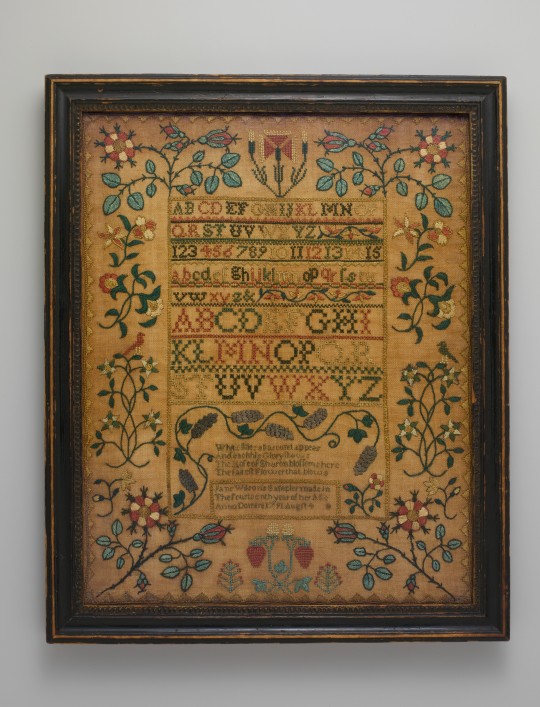
sampler embroidered by Jane Wilson, 14, in 1791 (MMA 2010.47)
or a picture:
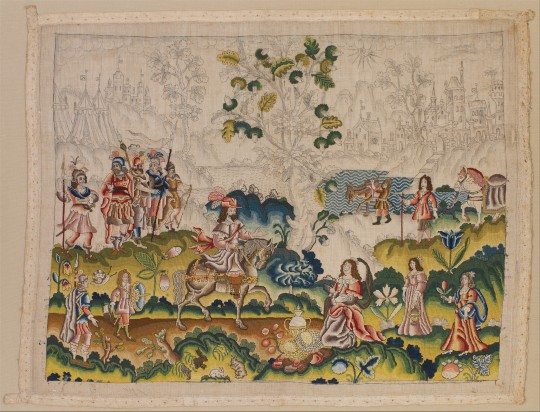
unfinished embroidery of David and Abigail, British, 1640s-50s (MMA 64.101.1325)
That is, something meant to hang on the wall for no real purpose.
These are forms of schoolwork, basically. Samplers were made by young girls up to their early teens, and needlework pictures were usually something done while at school or under a governess as a showpiece of what was being learned - not just the stitching itself, but also often watercolors (which could be worked into the design), artistic sensibility, and the literature, history, or art that might be alluded to. And many needlework pictures made in schools were also done as mourning pieces, sometimes blank, for future use, and sometimes to commemorate a recent death in the family. A lot of them are awkward, clearly just done to pass the class, but others are really artwork.
Many schools for middle- and upper-class girls taught the making of these objects (and other “ornamental” subjects) alongside a more rigorous curriculum - geography, Latin, chemistry, etc. At some, sewing was also always accompanied by serious reading and discussion. (And it would often be done while someone read aloud or made conversation later in life, too.)
Once done with their education, women generally didn’t bother with purely decorative work. Some things that fabric could be embroidered for included:
Jackets
Bed coverings and bedcurtains
Collars and undersleeves
Pelerines
Neck handkerchiefs and sleeve ruffles
Screens
Upholstery
Handkerchiefs
Purses, wallets, and reticules
Boxes
Book covers
Plus other articles of clothing like waistcoats, caps, slippers, gown hems, chemises, etc. Women’s magazines of the nineteenth century often gave patterns and alphabets for personal use.
(Not to mention late nineteenth century female artists who worked in embroidery, but that’s something else.)
You could purchase all of these pre-embroidered, but many, many women chose to do it themselves. There are a number of reasons why: maybe they wanted something to do, maybe they felt like they should be doing needlework for moral/gender reasons, maybe they couldn’t afford to buy anything - and maybe they enjoyed it or wanted to give something they made to a person they loved. That firescreen above was embroidered by Marie Antoinette, someone who had any number of other activities to choose from. It’s no different than people today who like to knit their own hats and gloves or bake their own bread, except that it was way more mainstream.
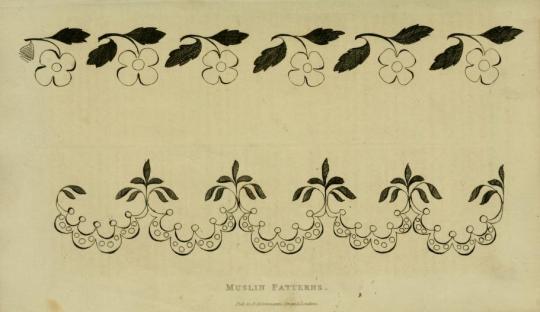
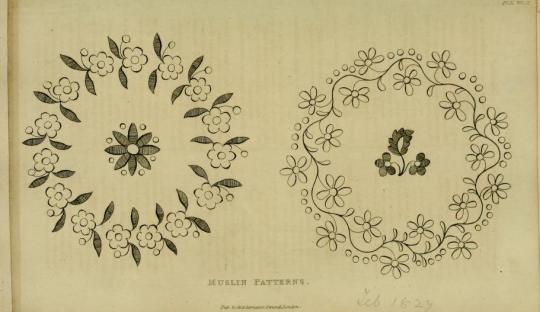
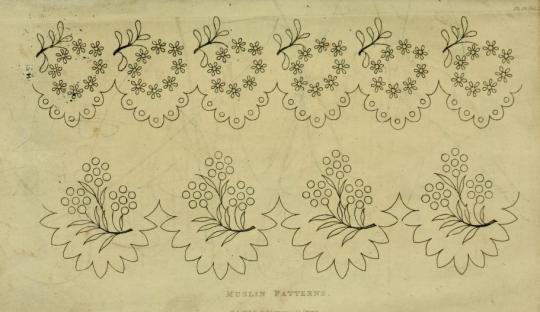
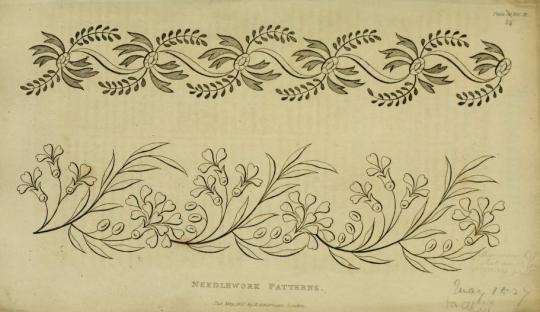

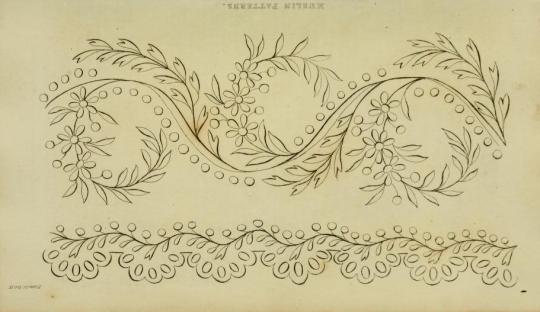
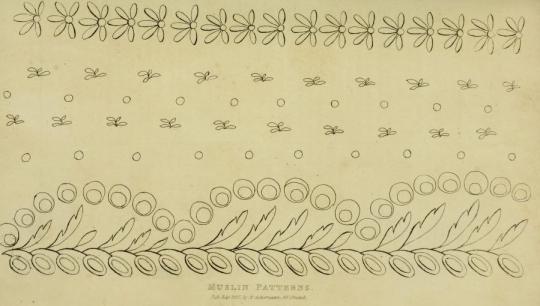
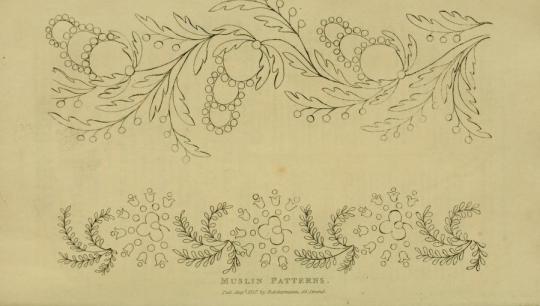
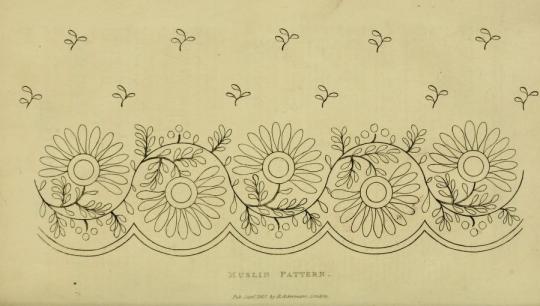
embroidery patterns from Ackermann’s Repository in 1827 - they could be used on dresses, collars, handkerchiefs, etc.
Second: needlework wasn’t the only “useless” thing women were expected to do
Ignoring the bulk of point one for now and the value of embroidery - I mentioned “ornamental subjects” above. As many people know, young women of the upper and middle classes were expected to be “accomplished” in order to be seen as marriageable. This could include skills like embroidery, drawing, painting, singing, playing the piano (as well as other instruments, like the harp or the mandolin), speaking French (if not also Italian and/or German), as well as broader knowledge and abilities like being well-versed in music, literature, and poetry, dancing and walking gracefully, writing good letters in an elegant hand, and being able to read out loud expressively and smoothly.
This wasn’t a checklist. As the famous discussion in Pride and Prejudice shows, individuals could have different views on what actually made a woman accomplished:
“How I long to see her again! I never met with anybody who delighted me so much. Such a countenance, such manners! And so extremely accomplished for her age! Her performance on the pianoforte is exquisite.”
“It is amazing to me,” said Bingley, “how young ladies can have patience to be so very accomplished as they all are.”
“All young ladies accomplished! My dear Charles, what do you mean?”
“Yes, all of them, I think. They all paint tables, cover screens, and net purses. I scarcely know anyone who cannot do all this, and I am sure I never heard a young lady spoken of for the first time, without being informed that she was very accomplished.”
“Your list of the common extent of accomplishments,” said Darcy, “has too much truth. The word is applied to many a woman who deserves it no otherwise than by netting a purse or covering a screen. But I am very far from agreeing with you in your estimation of ladies in general. I cannot boast of knowing more than half-a-dozen, in the whole range of my acquaintance, that are really accomplished.”
“Nor I, I am sure,” said Miss Bingley.
“Then,” observed Elizabeth, “you must comprehend a great deal in your idea of an accomplished woman.”
“Yes, I do comprehend a great deal in it.”
“Oh! certainly,” cried his faithful assistant, “no one can be really esteemed accomplished who does not greatly surpass what is usually met with. A woman must have a thorough knowledge of music, singing, drawing, dancing, and the modern languages, to deserve the word; and besides all this, she must possess a certain something in her air and manner of walking, the tone of her voice, her address and expressions, or the word will be but half-deserved.”
“All this she must possess,” added Darcy, “and to all this she must yet add something more substantial, in the improvement of her mind by extensive reading.”
Mr. Bingley feels that a woman is accomplished if she has the ability to do a number of different arts and crafts. Miss Bingley feels (or says she feels) that it goes beyond specific skills and into branches of artistic attainment, plus broader personal qualities that could be imparted by well-bred governesses or mothers. And Mr. Darcy, of course, agrees with that but adds an academic angle as well.
But what ties all of these accomplishments together is their lack of value on the labor market. A woman could earn a living with any one accomplishment, if she worked hard enough at it to become a professional, but young ladies weren’t supposed to be professional-level good because they by definition weren’t going to earn a living. All together, they trained a woman for the social and domestic role of a married woman of the upper middle or upper class, or, if she couldn’t get married, a governess or teacher who would share her accomplishments with the next generation.
(To be fair, almost none of the trappings of an upper-middle/upper class male education had anything to do with the kind of career training that college frequently is today, either. Men were educated to know the cultural touchpoints of their class and fit in with their peers.)
There are reasons that an individual person/character might specifically object to embroidery, but it was far from the only “useless” thing that an unconventional heroine would be required to do against her inclination by her conventional mother/grandmother/aunt/chaperone. Embroidery stands out to modern audiences because most of the other accomplishments are now valued as gender-neutral arts and skills.

“The Embroidery Frame”, by Mathilde Weil, ca. 1900 (LOC 98501309)
So, some thoughts for writers of historical fiction (or fantasy that’s supposed to be just like the 19th/18th/17th/etc century):
- If your heroine doesn’t like embroidery, she probably doesn’t like a number of other things she’s expected to do. Don’t pull out embroidery as either more expected or more onerous than them. Does she hate to sit still? I’d imagine she also dislikes drawing and practicing the piano. Would she prefer to do academic subjects? She probably also resents learning French instead of Latin, and music and dancing. Does she hate enforced femininity? Then she’d most likely have a problem with all of the accomplishments.
- If your heroine just and specifically doesn’t like embroidery, try to show in the narrative that that’s not because it’s objectively bad, and only able to be liked by the boring. Have another sympathetic character do it while talking to the heroine. Note that the hero carries a flame-stitched wallet that’s his sister’s work. Emphasize the heroine’s emotional connection to her deceased or absent mother through her affection for clothing or upholstery that her mother embroidered - or through a mourning picture commemorating her. There are all kinds of things you can do to show that it’s a personal preference rather than a stupid craft that doesn’t take talent and skill!

mourning picture for Daniel Goodman, probably embroidered by a Miss Goodman, 1803 (MMA 56.66)
#history#women's history#writing#embroidery#19th century#18th century#17th century#victorian#georgian#regency
1K notes
·
View notes